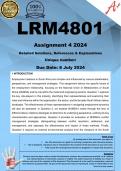LRM4801
Assignment 4 2024
Detailed Solutions, References & Explanations
Unique number:
Due Date: 8 July 2024
1 INTRODUCTION
Employment relations in South Africa are complex and influenced by various stakeholders,
perspectives, and management strategies. This assignment delves into specific facets of
the employment relationship, focusing on the National Union of Metalworkers of South
Africa (NUMSA) and its role within the metal and engineering sectors. Question 1 explores
the key role-players in this industry, identifying their representatives and examining their
roles and influence within the organisation, the sector, and the broader South African labour
landscape. The effectiveness of these representatives in navigating employment dynamics
will also be assessed. In Question 2, we analyse NUMSA’s notice through the lens of
different labour relations ideologies to determine its underlying perspective, outlining its key
characteristics and approaches. Question 3 provides an evaluation of NUMSA's conflict
management strategies, distinguishing between conflict resolution, settlement, and
management, and assesses the effectiveness and impact of these methods. Finally,
Question 4 requires an external environmental analysis from the viewpoint of the South
African Engineers and Founders Association (SAEFA), forming a reasoned argument in
Terms of use
response to NUMSA's demands, and presenting conclusions to theuse
By making Metal
of thisand Engineering
document you agree to:
• (MEIBC).
Industries Bargaining Council Use this document as a guide for learning,
This comprehensive comparison
approach aimsandto
reference
providepurpose,
a
• Not to duplicate, reproduce and/or misrepresent the contents of this document as your own work,
holistic understanding of the
• employment
Fully accept therelations dynamics
consequences in South
should you Africa's
plagiarise metal
or misuse and
this document.
engineering industries.
Disclaimer
Extreme care has been used to create this document, however the contents are provided “as is” without
any representations or warranties, express or implied. The author assumes no liability as a result of
reliance and use of the contents of this document. This document is to be used for comparison, research
and reference purposes ONLY. No part of this document may be reproduced, resold or transmitted in any
form or by any means.




